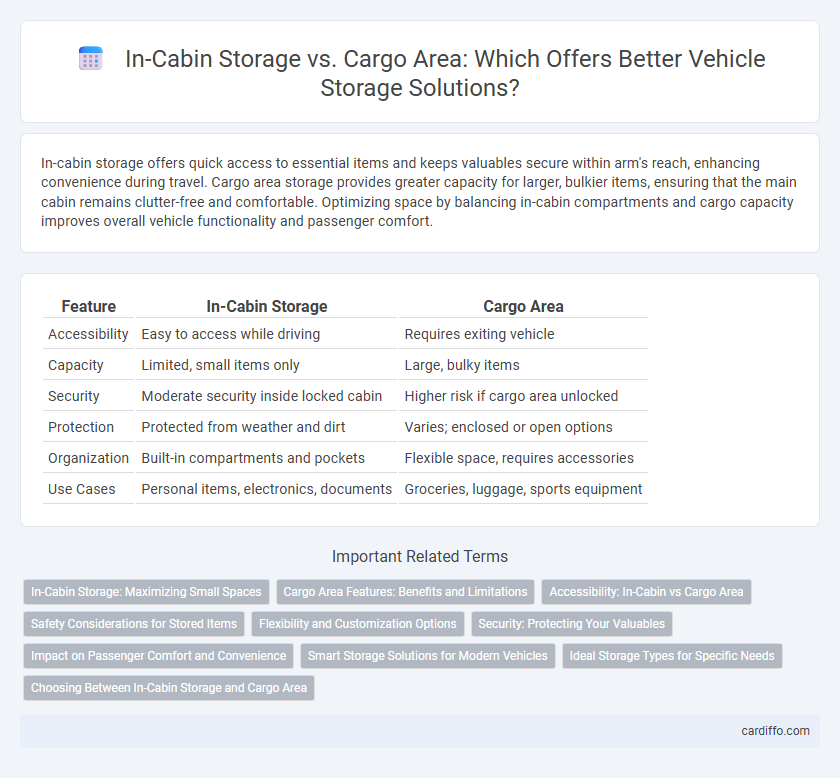In-cabin storage offers quick access to essential items and keeps valuables secure within arm's reach, enhancing convenience during travel. Cargo area storage provides greater capacity for larger, bulkier items, ensuring that the main cabin remains clutter-free and comfortable. Optimizing space by balancing in-cabin compartments and cargo capacity improves overall vehicle functionality and passenger comfort.
Table of Comparison
| Feature | In-Cabin Storage | Cargo Area |
|---|---|---|
| Accessibility | Easy to access while driving | Requires exiting vehicle |
| Capacity | Limited, small items only | Large, bulky items |
| Security | Moderate security inside locked cabin | Higher risk if cargo area unlocked |
| Protection | Protected from weather and dirt | Varies; enclosed or open options |
| Organization | Built-in compartments and pockets | Flexible space, requires accessories |
| Use Cases | Personal items, electronics, documents | Groceries, luggage, sports equipment |
In-Cabin Storage: Maximizing Small Spaces
In-cabin storage solutions maximize small spaces by utilizing compartments, under-seat trays, and door pockets, providing easy access to essentials while driving. Efficient organization within the cabin reduces clutter and enhances comfort during trips. Innovative designs incorporate multi-functional storage options to keep personal items secure and within reach.
Cargo Area Features: Benefits and Limitations
Cargo area features enhance storage capacity with spacious layouts, flat floors, and adjustable tie-downs that accommodate bulky and irregularly shaped items. Benefits include increased versatility for transporting large goods and easy accessibility for loading and unloading. Limitations involve potential exposure to dirt and damage without protective liners and less convenience for quick access compared to in-cabin storage compartments.
Accessibility: In-Cabin vs Cargo Area
In-cabin storage offers superior accessibility, allowing drivers and passengers to quickly reach essential items without exiting the vehicle. Cargo area storage, while providing larger capacity for bulkier items, often requires opening the trunk or rear hatch, which can be less convenient during quick stops or in adverse weather conditions. Ergonomic design and placement of compartments within the cabin significantly enhance user experience by minimizing disruption and optimizing ease of reach.
Safety Considerations for Stored Items
In-cabin storage offers quick access but requires securing items to prevent them from becoming projectiles during sudden stops or collisions, enhancing passenger safety. Cargo areas provide a safer environment for larger or heavier objects by isolating them from occupants, reducing injury risks in accidents. Properly anchored cargo and use of storage nets or dividers further minimize movement and potential hazards during transit.
Flexibility and Customization Options
In-cabin storage offers greater flexibility and customization options by allowing users to organize personal items within easy reach, using adjustable compartments, modular trays, and multi-purpose pockets. Cargo area storage provides ample space for larger items but lacks the tailored organizational solutions found inside the cabin, making it less adaptable for everyday use. Vehicles equipped with customizable in-cabin storage systems enhance convenience by accommodating diverse storage needs without compromising passenger comfort.
Security: Protecting Your Valuables
In-cabin storage offers enhanced security by keeping valuables within direct eyesight and allowing for easier monitoring during stops, reducing the risk of theft. Cargo areas, while spacious, are often less secure unless equipped with specialized locks or alarm systems, making them more vulnerable to unauthorized access. Choosing vehicles with integrated security features such as reinforced locks and alarm notification systems in both in-cabin and cargo compartments ensures optimal protection for stored items.
Impact on Passenger Comfort and Convenience
In-cabin storage enhances passenger comfort by providing easy access to personal items, reducing the need to reach into the cargo area during travel. It allows passengers to organize essentials within arm's reach, minimizing disruptions and increasing convenience on long journeys. Cargo area storage, while offering greater capacity, often limits accessibility and can lead to discomfort if passengers must frequent the rear space.
Smart Storage Solutions for Modern Vehicles
Smart storage solutions in modern vehicles optimize space by integrating in-cabin compartments such as under-seat drawers, door panel pockets, and center console organizers, enhancing accessibility and convenience for drivers and passengers. Advanced cargo area designs utilize configurable, modular systems including sliding trays, adjustable dividers, and fold-flat components to maximize load capacity and adapt to varying storage needs. Combining both in-cabin and cargo area innovations allows automotive manufacturers to offer versatile storage that improves overall vehicle functionality and user experience.
Ideal Storage Types for Specific Needs
In-cabin storage offers quick access to essentials like phones, wallets, and snacks, making it ideal for frequent use during travel. Cargo area storage provides ample space for larger items such as luggage, sports equipment, or groceries, catering to bulkier or less frequently needed goods. Choosing the right storage type depends on balancing immediate accessibility with the volume and size of items to optimize organization and convenience.
Choosing Between In-Cabin Storage and Cargo Area
Choosing between in-cabin storage and cargo area depends on accessibility and security needs; in-cabin storage offers easy reach for smaller items while keeping valuables within sight, whereas cargo areas provide larger capacity for bulky or heavy goods, isolating them from the passenger space. Prioritize in-cabin compartments for quick access to essentials like electronics or documents during travel, and rely on cargo space for luggage, sports equipment, or groceries to maximize comfort and organization. Consider material durability, locking mechanisms, and vehicle layout to optimize space utilization and ensure safe storage tailored to specific trip requirements.
in-cabin storage vs cargo area Infographic

 cardiffo.com
cardiffo.com